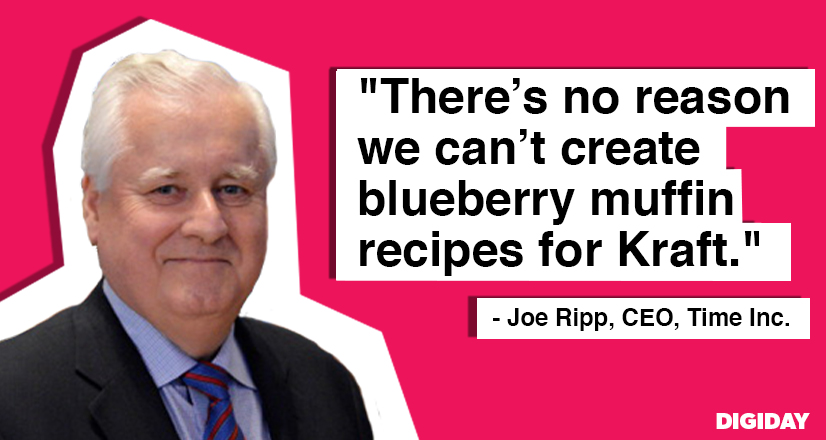
Time Inc. went public on Friday with the dubious distinction of being the only public company focused solely on magazines. Chief executive Joe Ripp, who took the reins last September, has been tasked with helping forge a future independent of Time Warner. With $1.3 billion in debt, the company needs to move fast to adapt to the Internet.
This is no small challenge: The company, which publishes Sports Illustrated, People and Time magazines, faces declining print advertising and circulation revenue, and only 15 percent of ad revenue coming from the online.
Ripp talked to Digiday about meeting Time Inc.’s digital challenges:
Time Inc. reaches a big audience, but it can be hard to do scale and innovation at the same time. How do you get this company to be as nimble as it needs to be?
We’ve really been focused on the cultural part of Time Inc. because I understood that was the biggest impediment to our success. There was not a Time Inc.-centered management. The opportunity for us now is to reinvest that cash flow for Time Inc. The opportunity is to do what we’ve done even better than we have before. To regain that digital momentum. To develop more products and services in video.
In terms of video, the company is catching up. But people don’t necessarily think of Time Inc. or its new hub, The Daily Cut, as a video destination. How do you change that?
I think you show them really high-quality stuff. As you see our products and services translate into video, you really get it. We cook thousands of recipes a year. We never filmed them. People say, they need to be studio-quality. Take a chicken recipe: It’s just a chicken. It doesn’t need to have studio-quality video around it. We will do studio quality at the same time. So I don’t look at this as anything revolutionary. It’s just catch up.
Programmatic is something Time Inc.’s put more emphasis on. But there are those who worry it will undermine publishers’ direct sales. What’s the opportunity here for the company?
Programmatic has been around for years. We sell remnant inventory. It’s a way for advertisers to improve their buying. In premium exchanges, our CPMs are as good as our premium rates.
Lot of publishers are leaning on native advertising as the antidote to low online CPMs. Is too big a deal made of whether native should be created and labeled separate from the editorial product?
We’ve got lots of different brands and lots of different opportunities. There’s no reason we can’t create blueberry muffin recipes for Kraft. So there is a range of opportunities to interact with advertisers. We will never confuse our reader.
Time Inc. just bought the startup Cozi, a household organizer app. What other ways do you see Time Inc. extending itself outside the ad and subscription business?
I’ve always looked at what [National Geographic Society chairman] John Fahey at Nat Geo did. He look a sleepy old magazine and made it into a multimedia powerhouse. Here’s the reason John Fahey is on our board right now. We have Food & Wine and Decanter in the U.K. You think, two wine magazine-company, so what. If I create a wine app and take a picture of the bottle, I have data on you. Think of wine tours. Think of wine product sales. The passions we serve, people want more and more of it.
That’s ambitious for a magazine company.
In the past, we’ve limited that distribution to just printed pages. I look at the opportunity for this business to go beyond. People should be much more on the Web; it should be more experiential. Time magazine should have more of a contributor network. Fortune should do events every year. All You is focused on people who love coupons. It’s not something people like to talk about in New York, but it’s very successful around the country.
Recently Time Inc. ruffled feathers when it introduced ads on the front covers of Time and Sports Illustrated. Do you expect to extend that format to the rest of Time Inc.’s titles?
I certainly hope so. They’re great ads for us. I can’t imagine there’s one consumer who cared. If you look at them, you’ll wonder what all the flap was about.
More in Media

Digiday Scorecard: Publishers’ rate Big Tech’s AI licensing deals
Digiday has compiled a scorecard grading AI platforms to make sense of the growing number of players in the AI content licensing market.

Publishers are hunting for AI prompt data — now they’re starting to get it from third-party companies
Publishers are finally gaining some visibility into AI search, as new prompt data tools crack open a black box.

Digiday+ Research: Publishers’ growing focus on video doesn’t translate to social platforms
Major publishers have made recent investments in vertical video, but that shift is not carrying over to social media platforms.






